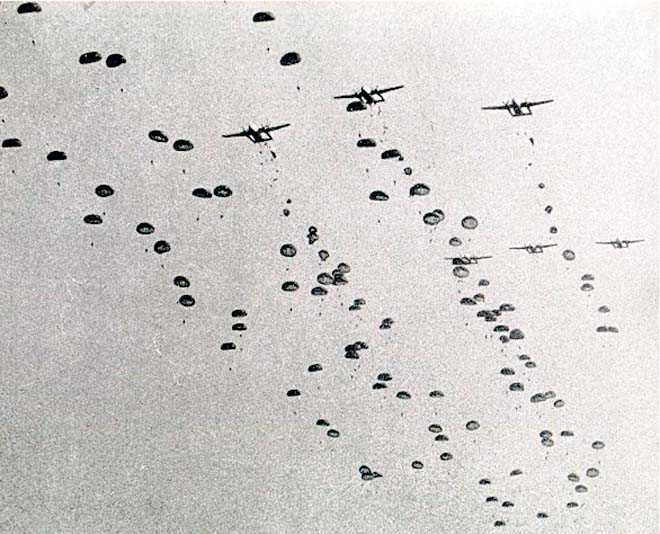
A picture of the ‘Tangail Airdrop’, an airborne operation launched on December 11, 1971, released by the PRO of the Defence Ministry.
Shubhadeep Choudhury
THE military treats its media interface as part of the information warfare (IW) package. A fine example of IW — perhaps the most successful in the history of the Indian Army to date — was revealed during the “Vijay Diwas” celebrations by the Army’s Eastern Command here.The Tangail Airdrop was an airborne operation launched on December 11, 1971 by the 2nd battalion of the Indian Army’s Parachute Regiment during the 1971 war with Pakistan.The airdrop and the subsequent capture of the Poongli Bridge gave the advancing Indian Army the manoeuvrability to side-step the strongly held Tongi-Dhaka Road to take the undefended Manikganj-Dhaka Road right up to the Mirpur Bridge at the gates of Dacca.Maj Gen Inder Singh Gill was the Colonel of the Para Regiment at that time. He met the Ministry of Defence PRO in Delhi before the airdrop, and asked him to ensure good publicity for the airdrop. This was critical for building up pressure on the East Pakistani military establishment. As the Army had no prior access to Tangail, photographs of the airdrop could not have been arranged. The PRO, Lt Col Ramamohan Rao, was not one to get dissuaded owing to such trifles. Rao had been to Agra a year earlier to cover an exercise by the 50th Independent Para Brigade. He fished out one of those pictures, and had it released with the caption that troops of the Indian Para Brigade were airdropped over East Pakistan in the morning of December 12.The 2nd Para Battalion, which was actually airdropped, could not have consisted more than 700 odd soldiers. A brigade, on the other hand, can have around 4,000-5,000 men. Rao had turned his constraint into an advantage!The next day international media carried the picture with the news that an entire para brigade was on its merry way to Dhaka. The rest, as the saying goes, is history. Gen AAK Niazi, the Pakistani military commander in the East caved in and surrendered with over 90,000 of his men. When asked later regarding the reason for his surrender, Niazi pointed to a copy of the Times London, on his desk, carrying the doctored picture of the “Tangail Para drop”.RN Kao, the founder of the external espionage agency Research & Analysis Wing (RAW) was impressed by Rao’s pyro techniques. He complimented Rao and the latter soon became a “kaoboy” as the spooks in the RAW were then called.
Didi’s cartoon blanked out
A leading English daily recently blanked out a cartoon on West Bengal Chief Minister Mamata Banerjee from its Kolkata edition.The decision drew flak from none other than Taslima Nasreen, the exiled Bangladeshi writer who occupied a central place in the cartoon.“The cartoon is about Kolkata and it’s CM. But this has not been published in Kolkata edition,” Nasreen, who had to leave Kolkata following violent protests by Muslim fanatics, tweeted.In the cartoon (published in all major editions of the paper, including Delhi and Mumbai), a caricature of Mamata is seen having a telephonic conversation with another woman who complains against curbing of her creative freedom by some patriarchal characters who enjoy the backing of the state. Mamata, touched by caller’s plight, addresses her as “Padmavati” (of the controversial movie of the same name) and says she is welcome to Bengal. The caller at the other end then says she is Taslima Nasreen, not “Padmavati”. Mamata, shocked, drops the receiver from her hand.Nasreen, who has earned the wrath of Islamic zealots because of her branding of the Islam as a misogynist religion, is in exile since 1994. She spent three years in Kolkata in the last decade. She left the city in 2007 following riotous protests by Muslim fanatics. The so-called secular Left Front government, which was in power in Bengal then, did not do anything to give her protection.Mamata Banerjee, who succeeded the communists, has also made it clear that Taslima is not welcome in Bengal. “She (Mamata Banerjee) thinks she will lose Muslim votes if she allows me to enter West Bengal”, Taslima (55), who has a fatwa on her head and now lives in the US, recently said in an interview.Mamata, even though she likes to appear as a staunch defender of the freedom of expression, does not take kindly to criticism. In the past, action had been taken against people for drawing her caricature and posting it on the Facebook.
